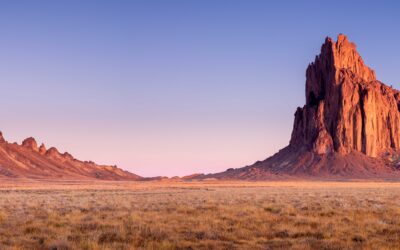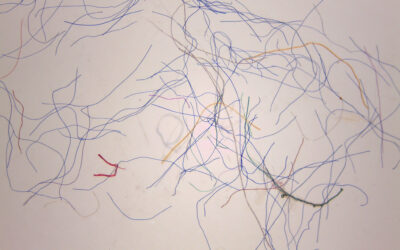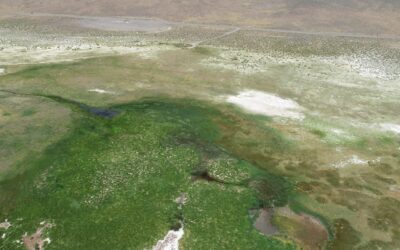With a new $2 Million grant from the National Science Foundation, an interdisciplinary team of researchers including Adam Watts, Ph.D. of the Desert Research Institute (DRI) in Reno are initiating an effort to develop new tools for assessing and mitigating wildfire risk. Watts, an associate research professor in fire ecology at DRI, will contribute expertise in fire surveying and data collection using unmanned aerial systems (UAS). Working alongside researchers from UCLA, University at Buffalo, National Center for Atmospheric Research in Boulder (NCAR), and the University of Nevada, Reno, Watts will help the project team to create a live digital platform that quantifies the risk of wildfires to wildland-urban interface communities in terms of probability of loss. The tool will be used by wildfire managers, emergency responders, and utility companies help them make informed decisions and take preventive actions in order to scientifically reduce the risk of fires.
The press release below is reposted with permission from the University of Nevada, Reno.
“Our lives should not be sacrificed this easily”: Camp Fire tragedy leads to new wildfire research
On November 8, 2018, the deadliest wildfire in California’s history ignited in Butte County outside the city of Paradise. When it was declared contained 17 days later, the Camp Fire had burned more than 150,000 acres, destroyed 18,000 buildings and taken 86 lives.
Like many, Hamed Ebrahimian, assistant professor in the College of Engineering, was moved by this tragedy. And when he discovered the fire was part of a growing trend of wildfire danger—for the last twenty years, on average, seven million acres of U.S. land have burned in wildfires annually—he got to work.
Harnessing his expertise in computational modeling in civil engineering, Ebrahimian began pursuing a better way to understand fire risk. He assembled a multi-institutional group of researchers with a similar desire to use science and technology to reduce the chances that the world would suffer from another wildfire of the magnitude of the Camp Fire. Now, with the help of a 5-year, $2 million grant from the National Science Foundation’s LEAP-HI program, Ebrahimian is ready to realize his vision.
“Some of the most tragic fatalities in the Camp Fire were due to unpredicted fire behavior, which surprised the victims and eliminated the proper reaction time. I told myself that we are in a digital and technology era and our lives should not be sacrificed this easily,” Ebrahimian said. “Two years later, I am grateful to be part of a solid team and to have received the support to execute this vision.”
The vision: A computational platform for multi-level wildfire risk assessment
Researchers at the Desert Research Institute (DRI), UCLA, University at Buffalo, National Center for Atmospheric Research in Boulder (NCAR), and the University of Nevada, Reno Colleges of Science and Business are gathered together under the leadership of the University’s College of Engineering to redefine wildfire risk monitoring and management through the development of a new computational platform. The platform is intended for use by wildfire managers, emergency responders and utility companies to plan for, respond to, and mitigate the risk of wildfires.
“This is an interdisciplinary intervention with a diverse team to blend different thinking modalities and to build a digital platform that can be used to monitor the risk of wildfire on a spectrum of spatial resolution and time,” Ebrahimian said. “Once developed, the computational platform will increase the efficiency of the wildfire management process by providing timely actionable information to decision-makers.”
The research project envisions an eventual live digital platform that evolves with new data and dynamically updates the long-term (seasons/months ahead) to short-term (weeks/days ahead) pre-ignition fire risks at regional and community scales for risk management, and the post-ignition fire behavior at near-real-time (hours-days) for situational awareness.
Ebrahimian explained, “Our objective is to develop a systematic framework to quantify the risk of wildfires to wildland-urban-interface communities in terms of the total probability of loss. Loss is defined as a combination of monetary damage and the change in the quality of life of people. The risk, thus, depends, on one hand, on the characteristics of the community, its structure, and location and, on the other hand, on the wildland and the factors affecting the fire ignition and spread, such as topography, climate conditions, fuel type and moisture. Now, we want to have the capability to combine all these factors and predict the seasons-month ahead to weeks-days-ahead risk for different communities and regions.”
This goal will be accomplished by creating and integrating transdisciplinary scientific knowledge and techniques in the fields of data harnessing (collection, processing, fusion, and uncertainty quantification), computational modeling (wild- and urban-fire initiation and spread, as well as social quality-of-life models), stochastic simulation, and model-based inference.
“This is a complex undertaking and requires the integration of various sources of data with a hierarchy of data-driven and physics-based models,” Ebrahimian continued. “The core idea is inspired by the many years of research advancement in the field of earthquake risk assessment and disaster resilience. Once developed and validated, the framework will be crucial to help make informed decisions and take preventive actions in order to scientifically reduce the risk of fires, and therefore, their effects on our communities and people. This can help reduce the risk of fires but the risk can never be eliminated. Therefore, another component of our computational platform is focused on predicting how active fires will behave and propagate. This will be instrumental to help the ground-zero firefighting activities.”
“A global concern”: collaboration through the NSF LEAP-HI program
Designed to challenge the engineering research community to take a leadership role in addressing demanding, urgent and consequential issues facing our nation, the Leading Engineering for America’s Prosperity, Health, and Infrastructure (LEAP-HI) program supports research that requires “sustained and coordinated effort from interdisciplinary research teams.” As such, LEAP-HI grants are complex, cross-disciplinary, and highly competitive—only a few projects are granted in each annual cycle. For Ebrahimian’s project, key contributions will come from engineers and scientists from institutions across the nation.
UCLA
Ertugrul Taciroglu
Ertugrul Taciroglu, professor and chair of the civil and environmental engineering department at the UCLA Samueli School of Engineering, will lead the development of advanced tools that will make use of computer vision and machine-learning techniques to extract terrain and fuel characteristics from satellite and drone data. He will also work on the development of the Bayesian model updating techniques that will assimilate live-data from an ongoing fire into a high-fidelity wildfire forward simulation code.
“This approach is expected to enable direct utilization of event data for physics-based, near-real-time predictions of fire propagation,” Taciroglu said. “Better characterization wildfire propagation will help improved understanding of loss risks as well as pre-emptive mitigation methodologies.”
Taciroglu’s current research focuses on combining physics-based and data-driven models using a variety of techniques ranging from the more-conventional Bayesian updating and particle-filtering approaches to machine learning. His research group is also developing various tools for extracting metadata from images and point clouds to be used for defining computational domains in a variety of applications ranging from earthquake engineering to wildfire modeling.
University at Buffalo
Negar Elhami-Khorasani (photo courtesy of The Onion Studio)
Negar Elhami-Khorasani, assistant professor in the Department of Civil, Structural and Environmental Engineering at the University at Buffalo (UB), will develop a data-driven urban fire spread model to evaluate risk of wildfire in wildland urban interface communities (WIC). She will study temporal and spatial spread of fire in WIC, considering uncertainties in urban fuel, landscape, vegetation, and environmental factors. She will work with the rest of the team to establish a continuous fire risk assessment framework moving from the wildland into the urban interface. She will also collaborate with the University of Nevada, Reno to translate total burned area in a community to economic losses and its effects on community residents’ perception of life.
“. . . [F]ires are projected to become more frequent and intense. The economic and social impacts of wildfires . . . represent a global concern.”
“Wildfires have always been part of the natural landscape for a healthy ecosystem, yet these fires are projected to become more frequent and intense,” Elhami-Khorasani said. “The economic and social impacts of wildfires have risen in recent years, and now represent a global concern.”
National Center for Atmospheric Research in Boulder (NCAR)
Branko Kosovic
Branko Kosovic, director of the Weather Systems and Assessment Program at the Research Applications Laboratory of the National Center for Atmospheric Research, will lead the NCAR effort on assessing wildland fire risk assessment. He will focus on combining satellite imagery with highly detailed weather forecasts, analyzing environmental conditions such as fuel moisture, and applying an advanced weather-fire computer model.
“The goal is to develop a unique system for detailed assessments of wildland fire risk, alerting residents and firefighters days to weeks in advance of the potential for a major fire,” Kosovic said. “Such predictions can be vital for reducing the likelihood of a major fire and enabling fire crews to respond more rapidly in the event of a blaze igniting.”
An expert on wildfire prediction, Kosovic has led the NCAR team that is developing an advanced weather–wildland fire behavior model for the Colorado Wildfire Prediction System. He also oversaw the development of a data product of daily dead and live fuel moisture across the contiguous United States, which combines satellite and surface observations using a machine learning model. Kosovic is the Chair of the Ad Hoc Committee on Wildfire Weather, Technology and Risk of the American Meteorological Society.
Desert Research Institute (DRI)
Adam Watts
From the Desert Research Institute (DRI), Adam Watts, associate research professor in fire ecology, will contribute his expertise in fire surveying and data collection using unmanned aerial systems (UAS).
“Collecting refined data though aerial surveillance is an important undertaking that will inform the properties of fuel on the ground for pre-ignition fire risk assessment,” said Watts. “We, moreover, have significant experience in flying instrumented UAS on active fires to collected near-real-time data that will be used for fire propagation and behavior predictions.”
Watts is UAS Lead for the Fire and Smoke Model Evaluation Experiment (FASMEE) project, and a certified Wildland Fire Ecologist and Wildland Fire Practitioner. These skills and connections will provide prescribed-fire observation opportunities, leveraged data resources, and valuable external collaborations as well as extension capabilities via DRI’s Science Alive programs. Watts also directs the Airborne Systems Testing and Environmental Research Laboratory, where expertise in UAS payload development and deployment over wildland fires will be used to support relevant project tasks.
The Colleges of Business, Science and Engineering at the University of Nevada, Reno
Amir Talaei-Khoei
In the College of Business, Amir Talaei-Khoei, associate professor, will extend the engineering approach of the team to a humanistic perspective. His main goal is to understand the underlying effects of wildfire on the quality of people’s lives, including their perception about their individual and social viabilities. Amir is looking into closing the loop by not only investigating physical damages caused by wildfires, but also exploring the changes in people’s quality of life. In this study, the quality of life assessment instruments will be employed for the first time to take a social and humanistic approach in understanding wildfire impacts. This perspective is the first of its kind.
Talaei-Khoei has previously taken a similar approach utilizing quality of life assessment instruments to understand the effect of aging in people’s individual and social enthusiasms. Amir’s experience in leading a global multi-institutional initiative for Improving Elderly’s Quality of Life will provide an infrastructure in which the impact of wildfire will be assessed. The Department of Information Systems at the College of Business in the University of Nevada, Reno has a group of experts in this area and will provide a collaborative environment that will support Talaei-Khoei’s work in wildfire.
Neil Lareau
Neil Lareau, assistant professor in the Atmospheric Sciences program of the Department of Physics, will lead the effort to collect real-time data on wildfire plumes and fire progression using state-of-the-science scanning lidars and radars. These scanning remote sensors can see into the dense ash surrounding a fire, thereby enabling researchers to probe fire evolution by measuring fire-generated winds, plume dynamics, and changes in the fire perimeter. These real-time data will be fed into the modeling components of the study to constrain, and ultimately improve, the model predictions of fire progression.
Hamed Ebrahimian
The research of Hamed Ebrahimian, assistant professor in the Department of Civil and Environmental Engineering, is mainly focused on integrating physics-based models with data for data assimilation, estimation, identification, model updating, and uncertainty quantifications. As the project PI, he will oversee the development of various project pieces and their integration into a unified whole. He will also contribute his research expertise to develop a stochastic simulation framework for probabilistic wildfire risk assessment. Further, he will integrate measurement data with computational fire models to improve fire behavior prediction capabilities.
Community Engagement
This research and the technological outcomes of the project will not have an impact without the contribution and guidelines of the community partners, including researchers, field experts, practitioners and fire management authorities. Therefore, an active outreach effort is embedded in the research execution plan.
“We are looking forward to work with the broader fire community to exchange knowledge and tune the research outcomes toward addressing the existing pain points and technical gaps. Our objective is to have a practical, adoptable, and useful technology framework, and for this, we welcome any collaborative efforts,” said Ebrahimian.
For Ebrahimian and the rest of the researchers, the education of academic scholars and motivating K-12 students is essential. A sustainable technology development effort necessitates a comprehensive educational component, which trains the future workforce to continue carrying the torch. The project will involve eight graduate students and one post-doctoral scholar in a convergence research environment, training the next generation of transdisciplinary experts and researchers on wildfire hazards. A new joint educational curriculum between the civil engineering and physics departments at the University of Nevada, Reno, is planned to train the future workforce in wildfire engineering. Finally, the project includes an educational outreach program that will target local schools through University K-12 outreach programs. This effort will yield lesson modules on wildfires, which will highlight the important roles of STEM research in developing novel solutions to emerging problems.
“This project exemplifies the engineering spirit. Through collaboration, it provides multiple lenses for understanding a pressing problem not only in the United States but around the world. It advances our common goal of protecting lives and increasing prosperity. Because it integrates essential educational components, it further ensures that the next generation will build on its successes,” University of Nevada, Reno College of Engineering Dean Manos Maragakis said. “We are proud of Hamed and his exceptional collaborators, and we are grateful for their contributions to our global community.”
Like the LEAP-HI wildfire project itself, this article represents a collaborative effort from Christine Lee (UCLA), Peter Murphy (UB), David Hosansky (NCAR), Justin Broglio (DRI), Allie Crichton (College of Business), Jennifer Kent (College of Science), Mike Wolterbeek (Marketing and Communications) and each member of the research team.


